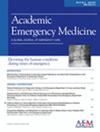Discharge instruction comprehension by older adults in the emergency department: A systematic review and meta‐analysis
IF 3.4
3区 医学
Q1 EMERGENCY MEDICINE
引用次数: 0
Abstract
IntroductionOlder adults are at high risk of adverse health outcomes in the post–emergency department (ED) discharge period. Prior work has shown that discharged older adults have variable understanding of their discharge instructions which may contribute to these outcomes. To identify discharge comprehension gaps amenable to future interventions, we utilize meta‐analysis to determine patient comprehension across five domains of discharge instructions: diagnosis, medications, self‐care, routine follow‐up, and return precautions.MethodsUsing Preferred Reporting Items for Systematic Reviews and Meta‐Analyses guidelines, two reviewers sourced evidence from databases including Medline (PubMed), EMBASE, Web of Science, CINAHL, and Google Scholar (for gray literature). Publications or preprints appearing before April 2024 were included if they focused on geriatric ED discharge instructions and reported a proportion of patients with comprehension of at least one of five predefined discharge components. Meta‐analysis of eligible studies for each component was executed using random‐effects modeling to describe the proportion of geriatric ED cases understanding the discharge instructions; where appropriate we calculated pooled estimates, reported as percentages with 95% confidence interval (CI).ResultsOf initial records returned (急诊科老年人对出院指导的理解:系统回顾与荟萃分析
导言:老年人在急诊科(ED)出院后很容易出现不良健康后果。先前的研究表明,出院的老年人对出院指导的理解程度不一,这可能会导致这些结果。为了找出患者在出院指导方面的理解差距,以便今后采取干预措施,我们利用荟萃分析法确定了患者在出院指导五个方面的理解情况:诊断、用药、自我护理、常规随访和返院注意事项。方法根据《系统综述和荟萃分析首选报告项目》指南,两名审稿人从Medline (PubMed)、EMBASE、Web of Science、CINAHL和Google Scholar(灰色文献)等数据库中寻找证据。2024 年 4 月之前发表的文献或预印文献,如果关注老年急诊室出院指导,并报告了能够理解五项预定义出院内容中至少一项内容的患者比例,均可纳入。我们使用随机效应模型对每项内容的合格研究进行了元分析,以描述老年急诊室病例中理解出院指导的比例;在适当的情况下,我们计算了汇总估计值,以百分比和 95% 置信区间 (CI) 的形式进行报告。结果在返回的初始记录(N = 2898)中,根据标题或摘要评估排除了 51 项研究,供全文审阅;其中 7 项构成了研究集。可接受的异质性和无发表偏倚迹象支持对理解药物说明比例(41%,95% CI 31%-50%,I2 = 43%)、自我护理比例(81%,95% CI 76%-85%,I2 = 43%)和常规随访比例(76%,95% CI 72%-79%,I2 = 25%)的汇总估计。主要发现包括在理解诊断(I2 = 73%)和返回注意事项(I2 = 95%)这两个出院参数方面存在明显的异质性。结论从急诊室出院的老年患者对自我护理和随访指导的理解程度高于对药物的理解程度。这些发现表明,用药指导可能是未来干预的优先领域。
本文章由计算机程序翻译,如有差异,请以英文原文为准。
求助全文
约1分钟内获得全文
求助全文
来源期刊

Academic Emergency Medicine
医学-急救医学
CiteScore
7.60
自引率
6.80%
发文量
207
审稿时长
3-8 weeks
期刊介绍:
Academic Emergency Medicine (AEM) is the official monthly publication of the Society for Academic Emergency Medicine (SAEM) and publishes information relevant to the practice, educational advancements, and investigation of emergency medicine. It is the second-largest peer-reviewed scientific journal in the specialty of emergency medicine.
The goal of AEM is to advance the science, education, and clinical practice of emergency medicine, to serve as a voice for the academic emergency medicine community, and to promote SAEM''s goals and objectives. Members and non-members worldwide depend on this journal for translational medicine relevant to emergency medicine, as well as for clinical news, case studies and more.
Each issue contains information relevant to the research, educational advancements, and practice in emergency medicine. Subject matter is diverse, including preclinical studies, clinical topics, health policy, and educational methods. The research of SAEM members contributes significantly to the scientific content and development of the journal.
 求助内容:
求助内容: 应助结果提醒方式:
应助结果提醒方式:


